Accueil > 04 - Livre Quatre : HISTOIRE CONTEMPORAINE > 08- Le mouvement noir aux USA > La révolte de la prison d’Attica
La révolte de la prison d’Attica
dimanche 9 août 2020, par
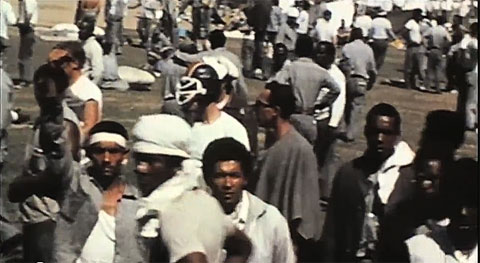
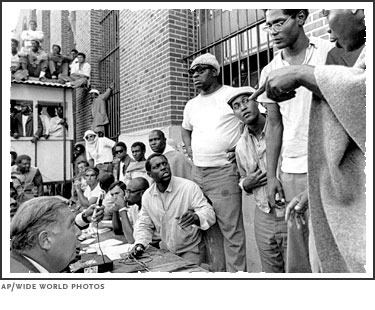
La révolte de la prison d’Attica
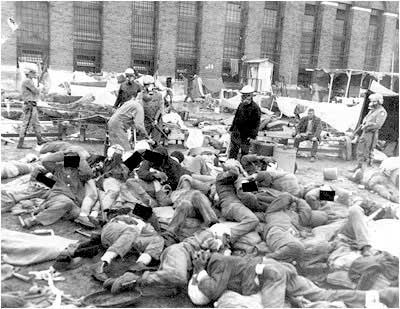
L’écrasement dans le sang de la révolte des prisonniers noirs de la prison d’Attica
1971 : La révolte de la prison d’Attica
Les mouvements pour les droits civiques et le pouvoir noir des années 60 et 70 ont généré un esprit révolutionnaire de révolte qui a touché tous les segments de la société, y compris la population carcérale. En septembre 1971, les détenus du centre correctionnel d’Attica à New York ont organisé une révolte qui a duré cinq jours.
Les conditions d’existence à Attica étaient horribles. L’établissement a été construit pour contenir 1 200 détenus, mais il en regorgeait de 2 225. Les détenus se sont vu refuser des installations sanitaires de base, n’avaient qu’une douche par semaine et un rouleau de papier toilette par mois. Environ 54% des détenus étaient noirs mais tous les gardiens de prison étaient blancs, ce qui a favorisé la violence et les tensions racistes.
Le soulèvement à Attica a été déclenché par le meurtre de George Jackson par des gardiens de prison. Jackson était un prisonnier révolutionnaire noir influent qui s’était politisé et avait rejoint les Black Panthers alors qu’il purgeait une peine de 23 ans à perpétuité pour un crime qu’il avait commis à 18 ans. Sa mort a provoqué des ondes de choc dans tout le pays, déclenchant des révoltes dans de nombreuses prisons, mais le plus puissant était à Attica.
Le 9 septembre, des prisonniers ont libéré un détenu qui devait être détenu dans sa cellule, puis ont cassé les portes pour envahir la cour. Plus de 1 000 prisonniers ont pu prendre le contrôle de la cour et de la prison, prenant 40 gardiens en otage. Ils exigeaient l’accès à la littérature, une meilleure nourriture et de meilleures conditions, et d’être traités comme des êtres humains. Comme les prisonniers l’ont dit dans leur déclaration au monde extérieur : « Nous sommes fermes dans notre détermination et nous exigeons, en tant qu’êtres humains, la dignité et la justice qui nous sont dues de plein droit. »
Tout le monde avait un rôle et quelque chose à apporter pendant la grève. Les grévistes se sont organisés en comités tels que la sécurité, la distribution de nourriture, l’élimination des déchets et la protection des otages. Malgré toutes les tensions raciales passées, il y avait un sentiment incroyable d’unité parmi les prisonniers comme jamais auparavant. Un attaquant noir a décrit : « Je n’ai jamais pensé que les Blancs pouvaient vraiment s’en sortir… J’ai en fait pleuré que c’était si proche, tout le monde si ensemble. »
Des négociations se sont déroulées de manière ouverte et démocratique entre les détenus, au cours desquelles les représentants ont relayé des informations aux grévistes de la cour. Malgré l’attention et le soutien de la communauté internationale, les responsables de la prison ont pu caler et ont refusé de bouger sur la question de l’amnistie. Après quatre jours de négociations entre les représentants des détenus et les responsables de la prison, Nelson Rockefeller, alors gouverneur de New York, a appelé à reprendre la prison.
La police a été mobilisée avec une brutalité incroyable. Munis de mitrailleuses et de gaz lacrymogènes, ils ont pris la prison, tuant sans discrimination, entraînant la mort de dix gardiens et employés de la prison ainsi que de 33 prisonniers. Des prisonniers ont été abattus alors qu’ils se rendaient, certains d’entre eux gisant sur le sol. Les survivants ont été battus avec des bâtons de nuit et contraints de ramper nus à travers du verre brisé. La presse a été interdite de la zone et n’a été informée de la brutalité que par des informations divulguées par la police et des survivants.
Pour la classe dirigeante américaine, l’Attica a dû être écrasée car elle représentait la révolte des prisonniers contre un système fondamentalement injuste. La capacité des détenus à s’organiser collectivement à travers les lignes raciales a fourni un exemple qui pourrait être lié aux mouvements sociaux plus larges qui balayent le reste de la société. Pour cette raison, le gouverneur Rockefeller était prêt à utiliser une brutalité incroyable pour écraser la grève.
Malgré la répression violente massive, le soulèvement de la prison d’Attica nous montre le potentiel des personnes les plus marginalisées à se rassembler et à lutter pour la justice et la dignité humaine fondamentale, même dans les pires conditions. Pour cette raison, l’Attica est devenue un symbole de la résistance des prisonniers dont on se souvient encore aujourd’hui du nom.
Trois téléfilms américains retraçant l’émeute ont été produits :
en 1980 : Révolte dans la prison d’Attica, de Marvin J. Chomsky, avec George Grizzard ;
en 1994 : Les Révoltés d’Attica (Against the Wall), de John Frankenheimer, avec Samuel L. Jackson.
en 2001 : Le Massacre d’Attica (The Killing Yard), de Euzhan Palcy, avec Alan Alda, Morris Chestnut et Rose McGowan (Showtime/Paramount) pour le 30e anniversaire des émeutes et du massacre.
Par ailleurs un documentaire intitulé Attica, également américain, a été réalisé en 1974 par Cinda Firestone.
Forty years since the Attica uprising
Nixon-Rockefeller tapes praise bloodbath—“A beautiful operation”
By Nancy Hanover - WSWS
This month marks the 40th anniversary of the 1971 uprising by prisoners at the Attica Correctional Facility in upstate New York and its bloody suppression by state police called in by New York Governor Nelson Rockefeller. The Attica rebellion was a major historical event, reflecting the acute social and political crisis of American imperialism at the height of the anti-Vietnam War movement, which coincided with a militant strike wave by industrial workers and the aftermath of the ghetto riots of the 1960s.
The homicidal response of the American ruling class to the protest by prisoners against inhumane conditions crystallized the brutal and violent character of class relations just beneath the surface of American life. Today, forty years later, the intensification of social tensions is leading to an unprecedented period of social upheavals as the US ruling class, in response to the world economic crisis and the protracted decline of American capitalism, prosecutes a social counterrevolution aimed at destroying all of the past social gains of the working class.
This gives the tragic events at Attica immense contemporary relevance. The political lessons of the Attica uprising are of great import today for working people and youth in the US and around the world.
On September 9, 1971, a skirmish at the Attica Correctional Facility in upstate New York escalated into an organized rebellion and political protest by 1,280 prisoners. Inmates seized prison guards as hostages, issued demands, and began four days of negotiations.
On September 13, Governor Nelson Rockefeller abruptly severed the talks and ordered a Vietnam-style assault by helicopters, state police sharpshooters and prison guards to retake the prison by force. Cell Block D, the scene of the uprising, was gassed and upwards of 3,000 rounds of ammunition were indiscriminately fired into the melee. Twenty nine inmates and 10 prison guards died in the carnage.
The New York State Special Commission on Attica, headed by Robert McKay of the New York University law school, held public hearings in April 1972. It said that the event, with the exception of massacres of Native Americans in the late 19th century, was “the bloodiest one-day encounter between Americans since the Civil War.”
At the time, the Bulletin, the weekly newspaper of the Workers League, forerunner of the Socialist Equality Party, stated that the bloodbath at Attica was premeditated and directed by the highest levels of the US government. The Bulletin warned that the military-style repression of the Attica inmates was a preparation for mass repression directed against the working class.
University of New Hampshire at Manchester Professor Theresa C. Lynch recently released to the public recordings of conversations between President Richard Nixon and Rockefeller that occurred in the immediate aftermath of the killings. These tapes corroborate the analysis of the Workers League : the slaughter at Attica was not a mistake or overreaction. It was a calculated political response to what was considered an intolerable challenge to the authority of the capitalist state.
What drove the inmates to rebel ?
Conditions at the prison, built in 1931, were notoriously brutal. Medical attention was often denied. The food was bad and sanitation non-existent. An all-white force of prison guards abused the inmates, predominately African-American and Puerto Rican, and deliberately provoked racial animosities.
Prisoners were allocated one roll of toilet paper a month. Muslims were denied the right to hold religious services, newspapers were banned from the library, and all mail was censored. Many young people were in prison for minor infractions, but bail was routinely set at impossibly high levels. Hard-core lifers were housed with those incarcerated for petty infractions.
These terrible conditions were at the root of the uprising, but it quickly assumed a political character. American society in 1971 was a tinderbox. Prison conditions were just one expression of a society riven by social contradictions.
Many of the young men incarcerated in New York prisons had been influenced by the rise of black and Puerto Rican nationalism and organizations such as the Black Panthers and Young Lords. These oppositional currents were fed by the failure of the civil rights movement to effect any real improvements for the majority of minority youth. This was the period of the Vietnam War and convulsive events such as the assassinations of Malcolm X (1965), Martin Luther King Jr. (1968) and, less than a month prior to the Attica rebellion, Black Panther member George Jackson (August 21, 1971).
The early 1970s was a period of intense struggle by the American labor movement against declining living standards, unemployment and attacks on the unions. In 1970, US postal workers walked out in their first national work stoppage and Nixon deployed the National Guard as strikebreakers to carry the mail. This was followed by a two-month strike of nearly 400,000 General Motors workers in the US and Canada. In July 1971, dock workers shut down all 56 ports on the West Coast.
On August 15, 1971 Nixon imposed a 90-day wage freeze and established a national pay board to control wage increases. This was part of a series of emergency measures taken to halt a run on the dollar. The most fateful of these was the removal of the gold backing of the dollar, which had been put in place as the centerpiece of the dollar-based world monetary system established at the Bretton Woods conference in 1944.
The wage freeze and pay board prompted wildcat strikes by workers in many unions throughout the country as well as calls for a general strike. The International Longshoremen’s Association, which represented the East Coast dock workers, joined the West Coast dockers’ strike in October. Nixon retaliated by invoking the anti-union Taft-Hartley law to force a return to work.
By 1971, over 50,000 Americans had died in the Vietnam War. The nation’s campuses and many cities were periodically convulsed by anti-Vietnam War protests and, in some cases, National Guard occupations. In May 1970, students protesting the expansion of the war into Cambodia were shot dead by National Guard troops at Kent State University in Ohio and by state police at Jackson State in Mississippi, sparking a student strike that shut down colleges and universities across the country. In 1971, the US further expanded bombing into Laos. In April of that year, more than half a million people protested against the war in Washington.
It was under these conditions of unprecedented domestic unrest and rising class struggle that the events at Attica occurred. The bourgeoisie had a lot to fear.
The uprising
In July, Attica prisoners petitioned the new corrections commissioner, Russell Oswald, regarding a series of grievances. Their demands included coverage by state minimum wage laws (many worked for 25 cents a day in temperatures above 100 degrees in the metal shop), political and religious freedoms, and betterment of living conditions. Attica was designed to hold 1,200 men, but was actually housing 2,225.
A meeting with Oswald, after numerous delays, was set take place in August. But on August 21, Black Panther Party member and “Soledad Brother” George Jackson was killed by prison guards in San Quentin, California.
Jackson, originally jailed for a $70 theft, had developed into a political figure through his correspondence (most famously with Angela Davis), after taking up a study of Marxism in prison. The day after Jackson’s killing, the prisoners at Attica held a silent fast in his memory and donned black armbands. In view of these events, Oswald decided the situation was too tense and he cancelled the meeting with the inmates.
“We were convinced that he [George Jackson] was murdered,” John Andrini, a member of the Attica Prisoners Negotiating Committee, told the Bulletin following the events in 1971. “The day they buried him, the whole prison population fasted, and I mean all the prisoners—blacks, whites, Indians, Puerto Ricans. They were fasting and the administration was very worried about this. In fact, we were wearing black armbands that morning when we got up and they made us take the armbands off… they were frightened to see how well we could get together, unite together.”
The Workers League stated presciently in an article published in the Bulletin : “The killing of Jackson was a political act aimed against the working class… Jackson’s murder came only days after Nixon’s orders to drive back the living standards of the working class. It is clear that the government is now preparing to unleash a wave of political repression in order to carry out its plans.”
On September 9, a fight broke out between inmates and guards. This was not an unusual occurrence. However, it was followed by a malfunction of the internal gate system. This enabled inmates to rush into the yards, take over the cellblocks and eventually seize 38 guards and civilian employees as hostages.
“I would say that the politically active inmates had a little foresight, took this riot over [from the lifers who started it]” explained Andrini. “They took the hostages away from this 10 percent of the people and formed it into an organized rebellion. They decided since the damage was done, that we were going to suffer the consequences anyway, let’s put it to some good use. Let’s right some of the wrong things that are perpetrated here at Attica.”
On the first day of the standoff the prisoners released prison guard William Quinn, who was severely injured in the original fight, and 11 other injured hostages so that they could get medical help. The prisoners set up an elected representative council to be spokesmen in the negotiations. They also established a protective human chain around the hostages and called for a group of outside observers to assist in the bargaining over grievances. Thirty-three people participated in this group, including New York Congressman Herman Badillo, State Assemblyman Arthur Eve, civil rights attorney William Kunstler, and Tom Wicker of the New York Times.
A series of 31 demands were drawn up, 28 of which Oswald eventually agreed to. The observers’ committee issued a public appeal to Governor Rockefeller to come to Attica to meet with them. Rockefeller refused.
On September 12, four of the observers telephoned Rockefeller and for 90 minutes pleaded with him to come to Attica to effect a peaceful solution, but the governor was unyielding. The decision had already been made to attack. The government would later claim that the inmates were slitting the throats of the hostages and even castrating them.
On Sunday morning, September 13, four days after the prisoners had seized control, the assault began. Two helicopters swooped down, dropping CN and CS pepper gas over the prison courtyard.
As prisoners and hostages fell to the ground, state troopers, correction officers, deputy sheriffs and park police opened fire with shotguns, pistols, Thompson submachine guns and .270 caliber rifles loaded with dum-dum bullets. They were firing blindly through thick clouds of gas.
Firing continued for about an hour. By the time the facility was retaken, the government had killed 9 hostages and 25 inmates, seriously injuring 89 others. One prison officer had been killed in the initial fight with inmates and 4 inmates had been killed by other inmates.
In the aftermath, guards and troopers brutalized the prisoners. Inmates were made to strip and crawl through lines of enraged officers. Witnesses said several men bled to death after being denied medical treatment.
Men were marked with “X”s on their backs and threatened with castration by vindictive prison guards. These attacks behind the prison walls went on for days.
According to Time magazine : “A team of doctors who treated prisoners in their cells later said inmates in widely separated parts of the prison described in identical detail instances of ‘indiscriminate’ firing by the officers and the calculated slaying of unresisting convicts. Reported Dr. Lionel Sifontes of Buffalo : ‘Many of the ringleaders were approached by guards and shot systematically. Some had their hands in the air surrendering. Some were lying on the ground.’”
Autopsies the next day showed that none of the lurid claims of executions or castrations were true. All but one of the deceased hostages were killed by the state assault.
Rockefeller calls Nixon
The transcripts of the discussion between Governor Rockefeller and President Nixon, now made available for the first time publicly, reveal the racism and contempt for human life of the two speakers—both leading representatives of the American ruling class. Exulting in the human carnage, they celebrate the success of the operation.
Nixon : I know you’ve had a hard day, but I want you to know that I just back you to the hilt... the courage you showed and the judgment in not granting amnesty, it was right, and I don’t care what the hell the papers or anybody else says. I don’t care what they say. I think that you had to do it that way, because if you would have granted amnesty in this case, it would have meant that you would have had prisons in an uproar all over this country.
Rockefeller : That’s right, absolutely.
Nixon : And you did the right thing. It’s a tragedy that these poor fellows were shot, but I just want you to know that’s my view, and I’ve told the troops around here they’re to back that right to the hilt.
Rockefeller : Well, aren’t you great, Mr. President. I only called you because I wanted to alert you that we were going in.
Nixon : Right.
Rockefeller then, in an extraordinary admission, replies “And when we went in, we couldn’t tell whether all 39 hostages would be killed and maybe two or three hundred prisoners.”
Rockefeller continues : "Well, you know this is one of those things. You can’t have sharp shooters picking off the prisoners when the hostages are there with them at a distance with tear gas without maybe having a few accidents."
Nixon : "Oh sure. Well, you saved a lot of the guards."
Rockefeller : "Thirty-two of them got out.”
Nixon : "That’s what I mean. It was worth it."
Commentators have pointed out that Rockefeller was preoccupied with dispelling his liberal reputation in view of the 1972 presidential primary season. No doubt this was a factor. But more fundamental issues were involved, and the decision to drown the uprising in blood was taken at the national level.
It reflected the fear within the ruling class of the growth of social opposition and political radicalism not simply among the inmates in one prison, but among broad sections of the working class and the youth in the US. The crushing of the Attica rebellion was intended to intimidate all those who were seeking to oppose the policies of the ruling class in Vietnam and elsewhere internationally as well as within the US.
The Bulletin commented at the time : “The government never had any intention of meeting these demands, but all the while they were preparing for the massacre. There was no room for compromise.” The following week, the Bulletin stated : “The warning is clear. When Rockefeller and the capitalist class are faced with a threat to their system they will use all the brutal force at their disposal to crush it.”
The tape documents the unvarnished racism which prevailed at the highest levels of the American political establishment. Throughout, Nixon refers to the rebellion—erroneously—as “basically a black thing” and is clearly concerned that Rockefeller’s policy should set a national example for how to respond to potential unrest among blacks.
Nixon : “You just stand firm there and don’t give an inch. Because I think in the country, you see, the example you set may stiffen the backs of a few other governors that may have a problem. But also in the country, too, I think that it might discourage this kind of a riot occurring someplace else… Tell me, are these primarily blacks that you’re dealing with ?”
Rockefeller : “Oh, yes, the whole thing was led by the blacks.”
Actually, the facts at Attica were different. Tom Wicker, the observer for the New York Times, reported how one prisoner shouted, “To oppressed people all over the world. We got the solution. The solution is unity.”
Wicker described the movement with “its strikingly effective organization, its fierce political radicalism, its submergence of racial animosity in class solidarity.” He explained : “That kind of organization, not to mention the unity displayed by the prisoners, would have been impossible if there had been racial discord in Block D… the human security chains were interracial ; the leadership committee features at least three white men, although the rebelling inmates must have been at least 84 percent black and Puerto Rican…”
In the September 27, 1971 Bulletin, the Workers League wrote : “All the outcries by liberals and clergy about Rockefeller’s ‘mistake’ at Attica will not change the fact that Rockefeller and Nixon consciously made a decision to murder the prisoners and will not hesitate to do so again. Even after Rockefeller knew that the hostages had been shot [by the state police] and that every statement about the prison officials was a lie, he stated : ‘There was no alternative but to go in.’ And he made it very clear why when he said that the prison revolt ‘had political implications beyond the reform of the prison which was not possible for us to conform to and at the same time preserve a free society.’”
The tapes confirm this analysis, showing that the massacre was the result of a political decision to use overwhelming force to quash what was deemed a challenge to the capitalist state.
Rockefeller : “We did it, though, only when they were in the process of murdering the guards, or when they were attacking our people as they came in to get the guards.”
Nixon : “You had to do it.”
Rockefeller : “And otherwise we recaptured all the cell blocks and so forth without shooting a shot. And no troopers were wounded. One of them—well, one of them was, in the leg. But—“
Nixon : “Only one trooper was wounded ?”
Rockefeller : “That’s right.”
Nixon : “Good, good, good.”
Rockefeller : “It really was a beautiful operation.”
“A beautiful operation” indeed ! Thirty-nine dead, many more tortured in the aftermath. As for the pretext for the raid—the safety of the hostages—Dr. John Edland, the medical examiner, said some had been shot by the attacking troopers and police “as many as 5, 10, 12 times” with “two types of buckshot and large caliber missiles.”
In the aftermath, the State of New York stonewalled the legal suits of families of both inmates and prison guards. Only in 2000 did the courts finally declare that inmates were “treated like garbage” and award $8 million to families of surviving inmates and hostages.
Forty years later, we live in a far more unequal and divided society, with unending wars and escalating social brutality. Attica was not an exception to the rule, but an expression of the rule itself. Behind the ever-growing class divide stands the violence of the capitalist state. This fact makes all more necessary the building of a political movement of the working class based on the lessons of history, including the tragic events of September 13, 1971.

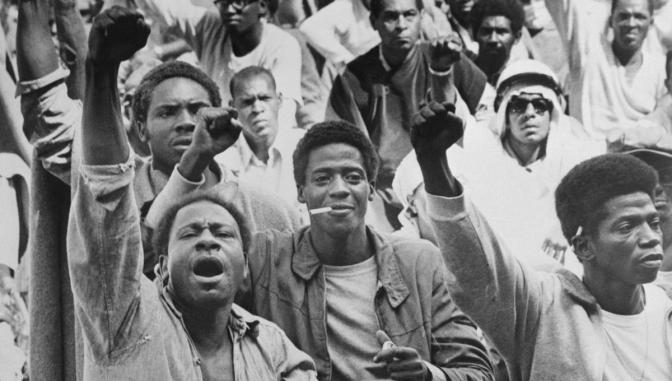
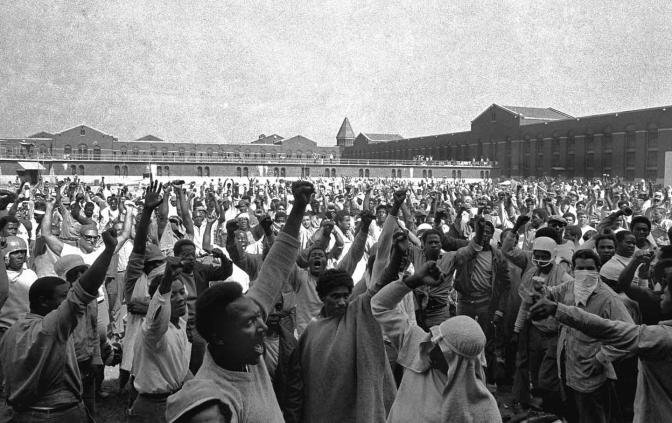
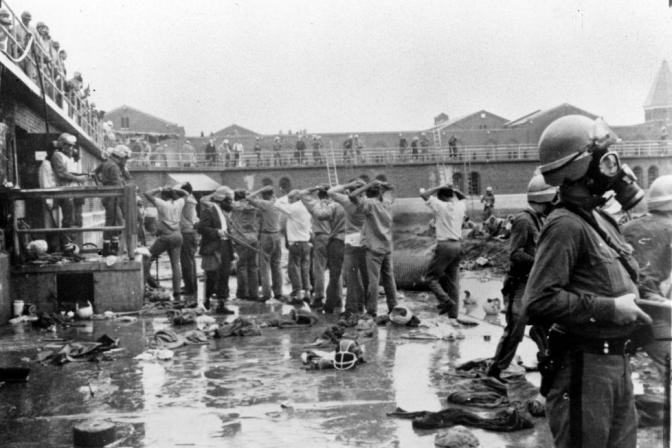
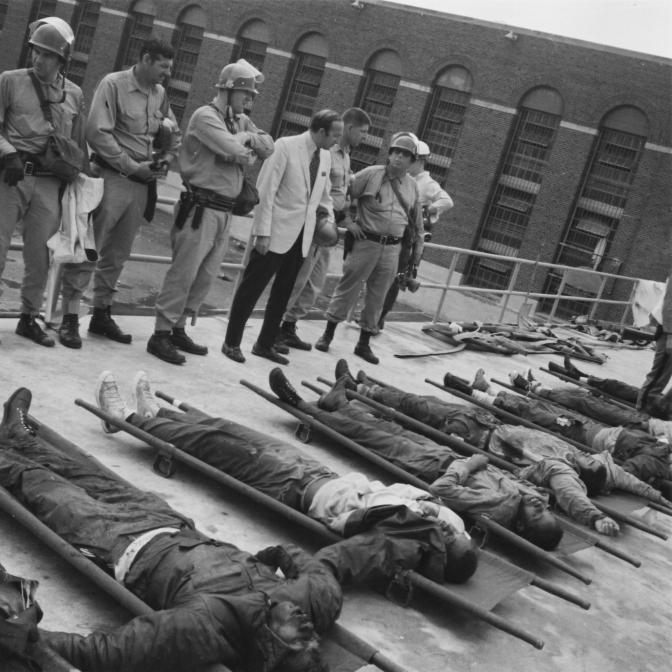


Messages
1. La révolte de la prison d’Attica, 24 septembre 2021, 09:12, par lucifer
Souvenez-vous de la révolte de la prison d’Attica
https://www.franceculture.fr/histoire/revolte-des-prisonniers-dattica-de-1971-du-traumatisme-a-la-prise-de-conscience